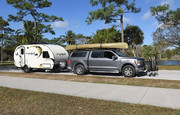Renogy solar suitcase
Printed From: R-pod Owners Forum
Category: R-pod Discussion Forums
Forum Name: Podmods, Maintenance, Tips and Tricks
Forum Discription: Ask maintenance questions, share your podmods (modifications) and helpful tips
URL: http://www.rpod-owners.com/forum_posts.asp?TID=12702
Printed Date: 27 Apr 2024 at 1:20pm
Software Version: Web Wiz Forums 9.64 - http://www.webwizforums.com
Topic: Renogy solar suitcase
Posted By: IdahoBoy
Subject: Renogy solar suitcase
Date Posted: 25 Mar 2019 at 7:09pm
| I currently have two 6v golf cart batteries and a solid 100w Renogy solar panel to keep them charged. I am thinking of purchasing the Renogy 100w solar suitcase for convenience. My question is, do I need 100w or will a 50w panel do for the two 6v? I have had no problems with the 100w panel, but if I can get by with less why not? |
Replies:
Posted By: podwerkz
Date Posted: 25 Mar 2019 at 7:21pm
|
100 watt panels put out about 5-6 amps in full sunlight, depending on several factors. A 50 watt panel will put out around 2.5 to 3 amps. Good enough to maintain a couple of 6v batteries but you wont see a gain if you are running anything like fans, lights, TVs or whatever. A 50w panel can just barely offset the 24/7 'phantom' loads like USB ports, propane detectors, fridge electronics, etc. There is not much left over for your devices like phone chargers, laptops etc. Keep in mind that cloudy days and/or shade will decrease the output dramatically.
------------- r・pod 171 gone but not forgotten! |
Posted By: IdahoBoy
Date Posted: 25 Mar 2019 at 8:43pm
| I will stick with the 100w then. Thanks for the information. |
Posted By: Ben Herman
Date Posted: 25 Mar 2019 at 9:40pm
| I have been using a 100w renogy suitcase for a few years now and am very satisfied with it. More than enough juice to keep my single 12v deep cycle battery topped up every day. |
Posted By: Pod People
Date Posted: 25 Mar 2019 at 9:46pm
|
We also have 2 6v GC batteries and use a 100w Renogy suitcase . We are very happy with the suitcase system as to quality and function. We odered ours without the attached charge controller. We purchased the same charge controller and mounted it inside the pod to keep it waterproof and accessable. we have used our suitcase for 2 seasons and this will be our 3rd year. We use a 25’ RV 30 amp extension cord to connect the panel to a 30 rv outlet on the side of the pod. The wiring goes from that outlet directly to the controller and then to the batteries. We used large guage wire in short runs to minimize voltage loss. There is a post of our installation that can be found in the search function.it is a couple of years old, so extend the search function time limits. That installation was in our 173. We have sold that unit and currently have the panel system installed in our 179 with a few changes. Hope this helps you Vann Vann ------------- Vann & Laura 2015 RPod 179 https://postimg.cc/0zwKrfB9"> 
|
Posted By: IdahoBoy
Date Posted: 25 Mar 2019 at 10:07pm
| I also have a controller mounted inside my 172. All I will need to do us make sure I have the right plug on the new suitcase. Thanks for the information. I want to be fully self-sufficient for a three month journey to western Alberta and British Columbia this summer now that I am retired :). |
Posted By: offgrid
Date Posted: 26 Mar 2019 at 6:35am
|
If you're interested enough and want to know how much electrical energy you're actually using daily for a long trip like you're planning, then here's a pretty easy way to estimate it. This assumes that your batteries are new-ish and healthy. You will need a voltmeter. Start with a fully charged battery, then go camping for a few days using your electrical devices as you normally would, but don't connect any charging sources. Wait until your battery is roughly around 50% discharged as indicated by the little panel lights. Then, disconnect the batteries from everything and let them rest a couple of hours. Measure the battery voltage and use a table like the one in this article to determine state of charge. For example, at rest a deep cycle lead acid battery should be around 12.0-2.1V when at 50% SOC. https://www.solar-electric.com/learning-center/batteries-and-charging/deep-cycle-battery-faq.html - https://www.solar-electric.com/learning-center/batteries-and-charging/deep-cycle-battery-faq.html Say you have a 200 amphour GC battery bank and you're at 50% SOC after 2 days. You are consuming about 0.5*200/2= 50 amphours per day. So now you know your consumption rate, at least for the particular conditions you encountered in those 2 days. Next, say you want to go 6 days before you move camp and can fully recharge you battery from your tow vehicle while moving to your next spot. You will need 50*6=300AH. You will start with 100 useable AH in the battery because you don't want to go below 50% SOC. So, you need to replenish 300-100=200AH in 6 days. You will need 33AH daily on average from your solar system to do that. You'll probably want to also have an alternative backup charging source like a genny or your tow vehicle if you get a run of cloudy days or are camped under trees. You can see that if you plan on moving camp every 2 days you wouldn't really need any soalr charging. Most places in the summer in north america will get at least 4 hours of full sun equivalent per day on a tilted south facing surface that's unshaded. So, you'll need about 33/4=8.25 amps of solar charging. Solar modules run at about 18V so that's 8.25*18=148 watts of solar. YMMV. ------------- 1994 Chinook Concourse 1995 RV6A Experimental Aircraft 2015 Rpod 179 - sold |